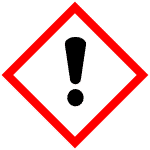1. Product information
Names
| Name | Phenol red |
|---|
| Synonym | More Synonyms |
|---|
Phenol red Biological Activity
| Description | Phenol red (Phenolsulfonephthalein) is a pH indicator dye, relying on a distinct color change from pink to yellow in case of a positive reaction[1] [2]. |
|---|
| Related Catalog | Research Areas >> Others Signaling Pathways >> Others >> Others |
|---|
| In Vitro | Phenol red (PR) is the standard pH indicator in various cell and tissue culture media, as it provides a quick check for the health of the culture. Phenol red has also been used in multiple protocols to detect cellular hydrogen peroxide as well as peroxidase activity from human peroxidase enzymes[1]. |
|---|
| References | [1]. Morgan A, et al. Caution for the routine use of phenol red - It is more than just a pH indicator. Chem Biol Interact. 2019;310:108739. [2]. Peltzer D, et al. Rapid and simple colorimetric loop-mediated isothermal amplification (LAMP) assay for the detection of Bovine alphaherpesvirus 1. J Virol Methods. 2021;289:114041. |
|---|
Chemical & Physical Properties
| Density | 1.5±0.1 g/cm3 |
|---|
| Boiling Point | 562.8±50.0 °C at 760 mmHg |
|---|
| Melting Point | 300 °C |
|---|
| Molecular Formula | C19H14O5S |
|---|
| Molecular Weight | 354.376 |
|---|
| Flash Point | 294.2±30.1 °C |
|---|
| Exact Mass | 354.056183 |
|---|
| PSA | 92.21000 |
|---|
| LogP | 3.02 |
|---|
| Vapour Pressure | 0.0±1.6 mmHg at 25°C |
|---|
| Index of Refraction | 1.697 |
|---|
| Storage condition | Store at RT. |
|---|
| Water Solubility | 0.77 g/L |
|---|
Toxicological Information
CHEMICAL IDENTIFICATIONCHEMICAL NAME : Phenol, 4,4'-(3H-2,1-benzoxathiol-3-ylidene)di-, S,S-dioxide
CAS REGISTRY NUMBER : 143-74-8
MOLECULAR FORMULA : C19-H14-O5-S
HEALTH HAZARD DATAACUTE TOXICITY DATAROUTE OF EXPOSURE : Subcutaneous
SPECIES OBSERVED : Rodent - rat
DOSE/DURATION : >600 mg/kg
ROUTE OF EXPOSURE : Intravenous
SPECIES OBSERVED : Rodent - rat
ROUTE OF EXPOSURE : Intravenous
SPECIES OBSERVED : Rodent - mouse
DOSE/DURATION : 1368 mg/kg
MUTATION DATADOSE/DURATION : 1 mg/plate
REFERENCE : AEMIDF Applied and Environmental Microbiology. (American Soc. for Microbiology, 1913 I St., NW, Washington, DC 20006) V.31- 1976- Volume(issue)/page/year: 42,641,1981 *** NIOSH STANDARDS DEVELOPMENT AND SURVEILLANCE DATA *** NIOSH OCCUPATIONAL EXPOSURE SURVEY DATA : NOHS - National Occupational Hazard Survey (1974) NOHS Hazard Code - 82224 No. of Facilities: 1719 (estimated) No. of Industries: 16 No. of Occupations: 13 No. of Employees: 5387 (estimated) NOES - National Occupational Exposure Survey (1983) NOES Hazard Code - 82224 No. of Facilities: 2166 (estimated) No. of Industries: 19 No. of Occupations: 26 No. of Employees: 27087 (estimated) No. of Female Employees: 14345 (estimated)
|
Safety Information
| Symbol | 
GHS07 |
|---|
| Signal Word | Warning |
|---|
| Hazard Statements | H315-H319-H335 |
|---|
| Precautionary Statements | P261-P305 + P351 + P338 |
|---|
| Personal Protective Equipment | dust mask type N95 (US);Eyeshields;Gloves |
|---|
| Hazard Codes | Xi:Irritant; |
|---|
| Risk Phrases | R36/37/38 |
|---|
| Safety Phrases | S37/39-S26 |
|---|
| RIDADR | NONH for all modes of transport |
|---|
| RTECS | SJ7490000 |
|---|
| Packaging Group | I; II; III |
|---|
| HS Code | 29349990 |
|---|
2. Packaging
For powders: normal is 25kgs/Drum or bag, or larger/smaller package as request.
For liquids: normal 25kgs/drum, 180-300kgs/bucket, or IBC, determined by the nature of the product.
Or smaller package 1kg/bottle, 10kgs/bottle as request.


3. Shipping

4. Contact information
For more details, pls contact us freely.
Mob: 86 17630971917
WhatsApp/Skype/Wechat/LINE: 86 17630971917



 China
China





